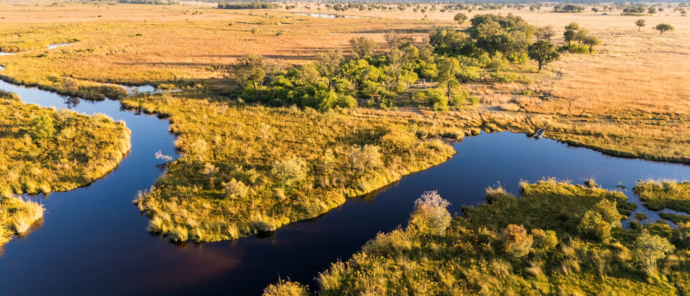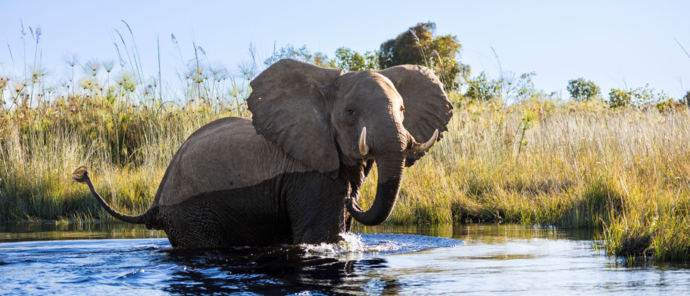Monachira Camp
The Quintessential Okavango Delta Safari Experience
Ten years ago, flying over the Okavango Delta in June, you’d look out the window to see the sun bouncing back at you from a never-ending expanse of water, broken only by reeds and the occasional hippo’s nose poking up from below.
The grey caps of termite mounds, clung to by stunted Mokolwane palms would hint at newly submerged islands, now small lifeboats of land, hemmed in by floodwaters. There was little point in trying to locate the permanent channels of the Boro and Monachira that carried the water with them, as their banks seemed to have permanently burst, having surrounded Chief’s Island and making an ocean of floodplains.

Ten years ago, a safari in the southern Okavango Delta was a mostly amphibious adventure, where guides demanded their Land Cruisers blend the lines between vehicle and boat.
An over-abundant Okavango made exploration by mokoro or boat the most practical mode between A and B. Traversing was tricky with herds of lechwe on every horizon, as water-averse lions and leopards shrunk back to the limited refuge of woodland. The cats of the southern delta mostly stayed unseen, for there were literal expanses of impossible-to-plough-through water in their way.
Fast forward to the last few years, and the dynamics of the Okavango Delta have shifted. With the vast majority of Okavango camps stretched out along the Boro River and her tributaries, safari camps that used to offer a water-focussed delta have seen their surrounding floodplains dry out.
Where the hippos and lechwe that used to thrive in shallow, but never-ending water have retreated to ever-shrinking channels, the dry grassland that remains has become the perfect hunting grounds for growing populations of wild dogs and cheetahs, and the lions tagging behind ever-increasing herds of buffalo that concertina along the remaining channels.
With less water, for less of the year, the southern delta has become a more diverse habitat where less water-loving wildlife can thrive.
At Monachira, we intend to emphasise the sense of floating atop an oasis in the reeds, where days are spent exploring the channels by boat while the Squacco Herons race alongside.

While this has been fantastic for our southern delta camps at Gomoti Plains and Kiri, it’s created less predictable water levels for travellers seeking out the classic Okavango Delta experience of being intentionally shipwrecked in the middle of the Kalahari Desert.
With the majority of the delta’s floodwater now pushing east along the Monachira Channel that runs along Moremi’s Game Reserve’s northern boundary, we’re incredibly excited for the opening of our new Monachira Camp in May 2025, at the edge of one of the delta’s few permanent waterways.
While the last few years have seen the water recede from elsewhere in the delta, the narrow but permanent ribbon of the Monachira remains, offering a year-round exploration of the waterways the Okavango has become so notorious for, but are now increasingly hard to find.

At Monachira, we intend to emphasise the sense of floating atop an oasis in the reeds, where days are spent exploring the channels by boat while the Squacco Herons race alongside.
We’ll mokoro around sandbanks in the style of safaris decades past, where islands are best explored on foot ahead of siestas with a picnic spread under the shade of sausage trees and nowhere to be for hours. Where time is something to keep, rather than spend, while you watch the horizon waiting for clouds of dust to evolve into a moving herd of buffalo, shifting into view.
Monachira is the perfect place to drift along. While Monachira Camp offers a small but productive web of game drive routes, the emphasis here is to search out water-adapted species now easier to find in a shrinking habitat, whether a Malachite Kingfisher, charismatic Sitatunga, or nesting Pel’s fishing owl.
Monachira Camp is being built to revive the truly wild explorations of the delta past and is a perfect complement to the intensity of bumping along on game drives at our other delta camps.








